- Clone
- MIG-2F5.5 (See other available formats)
- Regulatory Status
- RUO
- Other Names
- MIG-1, MIG
- Isotype
- Armenian Hamster IgG
- Ave. Rating
- Submit a Review
- Product Citations
- publications
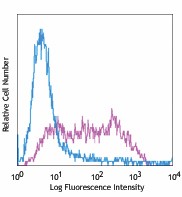
-

IFN-g-primed (2 hour) and LPS-stimulated (overnight) Balb/c peritoneal macrophages intracellularly stained with MIG-2F5 PE
| Cat # | Size | Price | Quantity Check Availability | Save | ||
|---|---|---|---|---|---|---|
| 515603 | 25 µg | 172€ | ||||
| 515604 | 100 µg | 341€ | ||||
MIG, also known as mig-1, CXCL9, is a member of the alpha subfamily of inflammatory chemokine. It is inducible in macrophages, hepatocytes, and endothelial cells by IFN-γ, but not by TNF-α or bacterial lipopolysacchrides (LPS). Mig functions as a chemotactic factor for resting memory and activated T cells, both CD4+ and CD8+, and natural killer cells. Furthermore, it was reported that Mig induced both calcium signals and chemotaxis in activated B cells and that B cell activation induced expression of mouse CXCR3. MIG and CXCR3 may be important not only to recruit T cells to peripheral inflammatory sites, but also in some cases to maximize interactions among activated T cells, B cells, and dendritic cells within lymphoid organs to provide optimal humoral responses to pathogens.
Product DetailsProduct Details
- Verified Reactivity
- Mouse
- Antibody Type
- Monoclonal
- Host Species
- Armenian Hamster
- Formulation
- Phosphate-buffered solution, pH 7.2, containing 0.09% sodium azide.
- Preparation
- The antibody was purified by affinity chromatography, and conjugated with PE under optimal conditions.
- Concentration
- 0.2 mg/ml
- Storage & Handling
- The antibody solution should be stored undiluted between 2°C and 8°C, and protected from prolonged exposure to light. Do not freeze.
- Application
-
ICFC - Quality tested
- Recommended Usage
-
Each lot of this antibody is quality control tested by intracellular immunofluorescent staining with flow cytometric analysis. For flow cytometric staining, the suggested use of this reagent is ≤ 1.0 µg per 106 cells in 100 µl volume. It is recommended that the reagent be titrated for optimal performance for each application.
- Excitation Laser
-
Blue Laser (488 nm)
Green Laser (532 nm)/Yellow-Green Laser (561 nm)
- Product Citations
-
- RRID
-
AB_2245490 (BioLegend Cat. No. 515603)
AB_2245489 (BioLegend Cat. No. 515604)
Antigen Details
- Structure
- A member of the alpha subfamily of inflammatory chemokine.
- Distribution
-
Inducible in macrophages, hepatocytes, and endothelial cells by IFN-γ.
- Function
- Recruit T cells to peripheral inflammatory sites, maximize interactions among activated T cells, B cells, and dendritic cells within lymphoid organs.
- Ligand/Receptor
- CXCR3
- Cell Type
- Macrophages
- Biology Area
- Immunology
- Molecular Family
- Cytokines/Chemokines
- Antigen References
-
1. Thapa M et al. 2008. J. Immunol. 180(2):1098
2. Whiting D et al. 2004. J. Immunol. 172 (12):7417
3. Helbig KJ. et al. 2009. J Virol. 83(2):836 - Gene ID
- 4283 View all products for this Gene ID
- UniProt
- View information about CXCL9 on UniProt.org
Related FAQs
- What type of PE do you use in your conjugates?
- We use R-PE in our conjugates.
Other Formats
View All CXCL9 Reagents Request Custom Conjugation| Description | Clone | Applications |
|---|---|---|
| Purified anti-mouse CXCL9 (MIG) | MIG-2F5.5 | ICFC,IP |
| PE anti-mouse CXCL9 (MIG) | MIG-2F5.5 | ICFC |
| Alexa Fluor® 647 anti-mouse CXCL9 (MIG) | MIG-2F5.5 | ICFC |
Customers Also Purchased
Compare Data Across All Formats
This data display is provided for general comparisons between formats.
Your actual data may vary due to variations in samples, target cells, instruments and their settings, staining conditions, and other factors.
If you need assistance with selecting the best format contact our expert technical support team.
-
Purified anti-mouse CXCL9 (MIG)
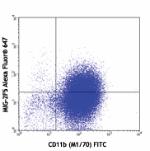
IFN-g stimulated peritoneal macrophages intracellular staine... 
IFN-g stimulated peritoneal macrophages intracellularly stai... -
PE anti-mouse CXCL9 (MIG)

IFN-g-primed (2 hour) and LPS-stimulated (overnight) Balb/c ... -
Alexa Fluor® 647 anti-mouse CXCL9 (MIG)

IFN-g stimulated peritoneal macrophages intracellular staine... 
IFN-g stimulated peritoneal macrophages intracellular staine...
 Login / Register
Login / Register 












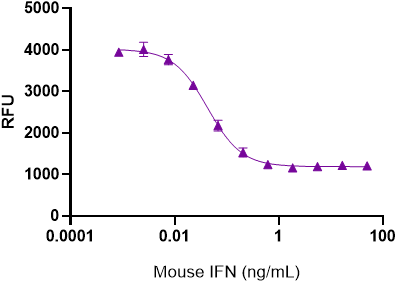
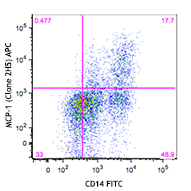
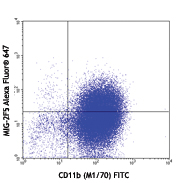



Follow Us